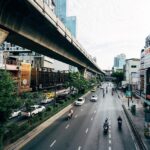Thailand’s red light districts represent a complex and controversial aspect of the country’s social and economic landscape, attracting significant global attention and generating complex discussions about tourism, social dynamics, and cultural intersections. These areas, primarily located in major urban centers like Bangkok and Pattaya, have evolved into intricate ecosystems that reflect broader socioeconomic challenges and historical patterns of economic migration. While often sensationalized in international media, these districts encompass nuanced realities that extend far beyond simplistic stereotypes, involving complex human experiences, economic survival strategies, and deeply rooted social structures.
Historical Context and Social Origins
The emergence of Thailand’s red light districts can be traced back to complex historical developments, including periods of economic instability, rural poverty, and limited economic opportunities for marginalized populations. During the Vietnam War era, the presence of international military personnel significantly transformed local entertainment districts, creating economic environments that would later develop into more structured red light areas. These zones initially emerged as survival mechanisms for individuals facing extreme economic hardship, particularly women from rural regions seeking alternative income sources.
Sociological research indicates that many individuals entering these industries come from economically disadvantaged backgrounds, often from northeastern Thailand’s rural provinces. The complex economic landscape has historically provided limited opportunities for social mobility, compelling many to seek alternative income strategies. Understanding these systemic challenges requires nuanced perspectives that recognize individual agency while acknowledging structural economic constraints.
Legal and Regulatory Landscape
Thailand’s legal framework surrounding adult entertainment remains intricate and often ambiguous. While prostitution is technically illegal, enforcement remains inconsistent, creating a complex regulatory environment. Local authorities typically adopt pragmatic approaches, focusing on maintaining public order and managing potential social disruptions rather than implementing strict prohibitive measures. This approach reflects broader cultural attitudes that recognize the economic realities underlying these industries.
Governmental regulations attempt to balance public health concerns, social stability, and economic considerations. Licensed entertainment venues must comply with specific operational guidelines, including health screenings, age verification protocols, and registration requirements. These regulations aim to mitigate potential exploitation risks while providing structured frameworks for legal adult entertainment establishments.
Geographic Concentration and Urban Dynamics
Red light districts are predominantly concentrated in major urban centers like Bangkok’s Patpong, Nana Plaza, and Soi Cowboy, as well as Pattaya’s Walking Street. These areas have developed sophisticated entertainment ecosystems that attract diverse international audiences. Each location possesses unique characteristics, reflecting local cultural nuances and specific economic dynamics. Bangkok’s districts, for instance, tend to be more structured and regulated compared to more informal settings in smaller cities.
The spatial organization of these districts reveals complex social negotiations, with distinct zones catering to different demographic segments. Some areas target international tourists, while others serve local populations. This segmentation demonstrates the sophisticated economic strategies employed within these entertainment landscapes, challenging simplistic external perceptions.
Economic and Social Implications
The economic significance of these districts extends beyond immediate entertainment revenues. They represent substantial economic ecosystems generating significant indirect economic activity, including hospitality, transportation, and ancillary service industries. Annual estimates suggest these entertainment zones contribute hundreds of millions of dollars to local economies, creating complex interdependencies between various economic sectors.
However, these economic benefits coexist with significant social challenges, including potential human trafficking risks, gender inequalities, and systemic vulnerabilities. Responsible engagement requires acknowledging these multifaceted dynamics, recognizing individual human experiences while understanding broader structural contexts.
Safety and Ethical Considerations
Visitors to these areas must prioritize personal safety, exercise cultural sensitivity, and maintain ethical awareness. Recommended precautions include maintaining situational awareness, avoiding excessive alcohol consumption, respecting local cultural norms, and understanding potential legal complexities. Responsible engagement necessitates comprehensive understanding and respectful interactions that recognize individual human dignity.
International travelers should remain cognizant of potential legal consequences, health risks, and ethical considerations. Comprehensive research, cultural understanding, and responsible decision-making are paramount when navigating these complex social environments.
Conclusion
Thailand’s red light districts represent far more than simplistic stereotypes, embodying complex social, economic, and cultural intersections. Understanding these spaces requires nuanced perspectives that recognize individual experiences, structural challenges, and broader societal dynamics. While controversial, these districts reflect profound economic realities and human survival strategies. Responsible engagement demands empathy, cultural understanding, and recognition of the complex human experiences underlying these intricate social landscapes.









